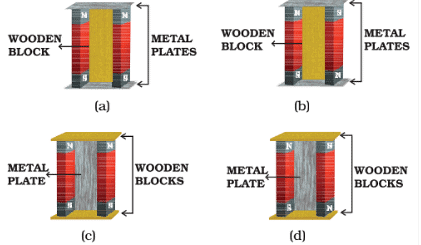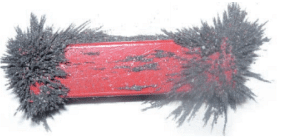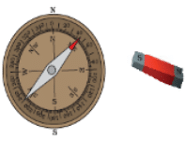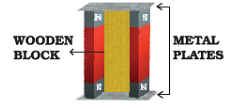NCERT Exemplar Solutions: Fun with Magnets | Science Class 6 PDF Download
| Table of contents |

|
| Multiple Choice Questions |

|
| Very Short Answer Questions |

|
| Short Answer Questions |

|
| Long Answer Questions |

|
Multiple Choice Questions
Q1: Observe the pictures A and B given in fig 13.1 carefully. Which of the following statement is correct for the above given pictures?
Which of the following statement is correct for the above given pictures?
(a) In A, cars 1 and 2 will come closer and in B, cars 3 and 4 will come closer.
(b) In A, cars 1 and 2 will move away from each other and in B, cars 3 and 4 will move away.
(c) In A, cars 1 and 2 will move away and in B, 3 and 4 will come closer to each other.
(d) In A, cars 1 and 2 will come closer to each other and in B, 3 and 4 will move away from each other.
 View Answer
View AnswerAns: (d)
In A, cars 1 and 2 will come closer to each other and in B, 3 and 4 will move away from each other.
Unlike poles attract each other while like poles repel each other.
In case A: cars 1 and 2 are facing each other with opposite poles hence they get attracted.
In case B: cars 3 and 4 are facing each other with the same poles hence they get repelled.
Q2: The arrangement to store two magnets is shown by figures (a), (b), (c) and (d) in fig 13.2. Which one of them is the correct arrangement?
 View Answer
View AnswerAns: (b)
option ‘b’ is the correct arrangement.
Q3: Three magnets A, B and C were dipped one by one in a heap of iron filing. Figure 13.3 shows the amount of the iron filing sticking to them. The strength of these magnets will be
The strength of these magnets will be
(a) A > B > C
(b) A < B < C
(c) A = B = C
(d) A < B > C
 View Answer
View AnswerAns: (a)
The amount of the iron filing sticking to magnets is directly proportional to their strengths.
Q4: North pole of a magnet can be identified by
(a) Another magnet having its poles marked as North pole and South pole.
(b) Another magnet no matter whether the poles are marked or not.
(c) Using an iron bar.
(d) Using iron filings.
 View Answer
View AnswerAns: (a)
Another magnet having its poles marked as the north pole and south pole.
Q5: A bar magnet is immersed in a heap of iron filings and pulled out. The amount of iron filing clinging to the
(a) North Pole is almost equal to the South Pole.
(b) North pole is much more than the South Pole.
(c) North pole is much less than the South Pole.
(d) Magnet will be same all along its length.
 View Answer
View AnswerAns: (a)
Magnetic strengths of the North Pole and the South Pole of a magnet are same.
Very Short Answer Questions
Q6: Fill in the blanks.
(i) When a bar magnet is broken; each of the broken part will have _________ pole/poles.(ii) In a bar magnet, magnetic attraction is _____ near its ends.
 View Answer
View Answer(i) two
(ii) more
Q7: Paheli and her friends were decorating the class bulletin board. She dropped the box of stainless steel pins by mistake. She tried to collect the pins using a magnet. She could not succeed. What could be the reason for this?
 View Answer
View AnswerThe pins are made of stainless steel which is a non-magnetic material. Hence Paheli was unsuccessful in collecting the pins using a magnet.
Q8: How will you test that ‘tea dust’ is not adulterated with iron powder?
 View Answer
View AnswerWe can use a magnet to test that tea dust is not adulterated with iron powder. If it has iron powder it will stick to the magnet.
Q9: Boojho dipped a bar magnet in a heap of iron filings and pulled it out. He found that iron filings got stuck to the magnet as shown in fig 13.4. (i) Which regions of the magnet have more iron filings sticking to it?
(i) Which regions of the magnet have more iron filings sticking to it?
(ii)What are these regions called?
 View Answer
View Answer (i) The ends of the magnet have more iron filings attached to it.
(ii) Magnets have two poles, namely the North Pole and the South Pole. Hence, these regions are called poles of the magnet.
Short Answer Questions
Q10: Four identical iron bars were dipped in a heap of iron filings one by one. Figure shows the amount of iron filings sticking to each of them. (a) Which of the iron bar is likely to be the strongest magnet?
(a) Which of the iron bar is likely to be the strongest magnet?
(b) Which of the iron bars is not a magnet? Justify your answer.
 View Answer
View Answer(a) Iron bar (a) is likely to be the strongest magnet since more amount of iron filings have stuck to the magnet than any other bars.
(b) Iron bar (b) is not a magnet since none of the iron filings sticks to the magnet.
Q11: A toy car has a bar magnet laid hidden inside its body along its length. Using another magnet how will you find out which pole of the magnet is facing the front of the car?
 View Answer
View AnswerWe know that unlike poles attract each other while like poles repel each other. In case of a toy car, if the front of the toy car gets attracted to the north pole of the given magnet then it is the south pole of the bar magnet hidden inside the car and vice-versa.
Q12: Match column I with column II (One option of A can match with more than one option of B.
 View Answer
View AnswerHere is the correct match:
Q13: You are provided with two identical metal bars. One out of the two is a magnet. Suggest two ways to identify the magnet.
 View Answer
View AnswerThere can be following ways to identify the magnet out of the two identical metal bars:
(i) By attracting iron filings to the magnet we get to know which is a magnet.
(ii) By using another magnet. If it is a magnet, like poles will repel each other while unlike poles will attract each other.
Long Answer Questions
Q14: Three identical iron bars are kept on a table. Two out of three bars are magnets. In one of the magnet the North-South poles are marked. How will you find out which of the other two bars is a magnet? Identify the poles of this magnet.
 View Answer
View AnswerThe magnet on which the North-South poles are marked can be used to find the magnet out of two bars.
Take the magnet with North-South poles are marked, keep it close to both the iron bars, hence both magnets get attracted to it since both are magnets.
To find out the poles of an unknown magnet, we can use the repulsion test. North pole marked on the given magnet will repel the north pole of the unknown magnet and vice-versa.
Q15: Describe the steps involved in magnetising an iron strip with the help of a magnet.
 View Answer
View AnswerAn iron strip can be magnetised by rubbing it with a magnet in a particular direction again and again as shown in below figure. Here are the steps involved:
Here are the steps involved:
- Consider a wooden table and place the desired iron strip which has to be magnetised.
- Now take a bar magnet where, one end of the magnet is held in the hands and the other end is on one edge of the strip.
- Rub the magnet again and again, without lifting along the length of the strip.
- Repeat the above steps several times.
- Take the iron fillings and extend it on the strip. If it gets attracted the strip gets magnetised and if it does not then repeat the steps few more times.
Q16: Figure 13.6 shows a magnetic compass. What will happen to the position of its needle if you bring a bar magnet near it? Draw a diagram to show the effect on the needle on bringing the bar magnet near it. Also draw the diagram to show the effect when the other end of the bar magnet is brought near it.
 View Answer
View Answer

Q17: Suggest an activity to prepare a magnetic compass by using an iron needle and a bar magnet.
 View Answer
View AnswerTo prepare a magnetic compass, place the given iron needle on a wooden table now magnetize by rubbing a bar magnet over it repeatedly in a particular direction without lifting it. After that, it may be set in a way so that it can rotate freely when suspended. Hence, the iron needle can act as a compass and give north-south direction.
Q18: Boojho kept a magnet close to an ordinary iron bar. He observed that the iron bar attracts a pin as shown in fig 13.7. What inference could he draw from this observation? Explain.
What inference could he draw from this observation? Explain.
 View Answer
View AnswerHe could infer from this observation that the iron bar is induced with magnetic properties and iron bar acts as a magnet till the magnet is kept near it.
Q19: A bar magnet is cut into two pieces A and B, from the middle, as shown in figure 13.8. Will the two pieces act as individual magnets? Mark the poles of these two pieces. Suggest an activity to verify your answer.
Will the two pieces act as individual magnets? Mark the poles of these two pieces. Suggest an activity to verify your answer.
 View Answer
View AnswerYes, the two broken pieces A and B will act as individual magnets. A magnet will always have two poles – the North and South Pole. Hence, now each piece will have two poles. By using the test of repulsion between the newly formed magnets we can detect the poles of broken magnets.
Q20: Suggest an arrangement to store a U shaped magnet. How is this different from storing a pair of bar magnets?
 View Answer
View AnswerU shaped magnet – One metal plate is placed across the two poles of the U shaped magnet to store it. Bar magnet – Two metal plates and one wooden block is used and arranged as shown in the figure.
Bar magnet – Two metal plates and one wooden block is used and arranged as shown in the figure.
|
100 videos|261 docs|49 tests
|
FAQs on NCERT Exemplar Solutions: Fun with Magnets - Science Class 6
| 1. What are the different types of magnets? |  |
| 2. How do magnets attract or repel each other? |  |
| 3. What is the Earth's magnetic field and how does it work? |  |
| 4. How can we make a simple magnet at home? |  |
| 5. What are some practical applications of magnets in everyday life? |  |

|
Explore Courses for Class 6 exam
|

|

















